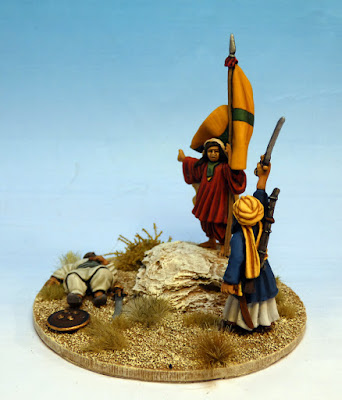I recently explained my method of which manufacturer and the specific colours I was using to get the particular yellow on the Spanish Arquebusiers above and was politely informed I must not be using Vallejo Model Colour, which I was(!), and that I must be using Army Painter paints, which I was not! I thought that this one needed to be tucked into bed so decided to do a quick post.
Note, this is but one hue or yellow and there are obviously many other ways of reaching a similar or indeed, a very different goal. Many ways of adding shade to a "yellow", such as applying a complimentary colour like a "violet" but these methods are largely based on colour theory that was developed for paintings on canvas, board or for use in Graphic Design etc. and not for the 28mm miniatures that we want to get on the wargames table. Not that I would ever discourage anyone from experimenting. Colour theory has it's place, on single pieces or pieces aimed at competition painting but, in my humble opinion, not for the purpose at hand, getting them on the table ship shape and Bristol fashion.
Of course, it is possible to start a "yellow" from a lighter or darker base of any suitable colour, I have used Ochres, Light browns, Dark Browns to different effect a myriad of different models. I usually avoid the obvious trap of going to an Orange base for the "yellow". This is fine for many layers and blending (mostly on larger models) but not very useful for the four or five layers I usually aim for. Here a degree of compromise and an acceptance that there will be a higher degree of contrast between the original tone and the final highlights are key.
Whilst I type this, I think a disclaimer of sorts is important. I think is necessary to stress that we all have different ways of applying and mixing paint different ways of going about things with the brush. This small article as a means to answering a question I have been asked many times on the internet on many fora, "How do you go about painting yellows?". There is no right or wrong way of going about this but hopefully this little article will go someway to explaining how I go about the business of painting yellows. Many might disagree with my simple method, which is fine.
The actual method to create this type of "Yellow" is pretty simple. I start with Vallejo Model Colour Orange Brown and simply mix in a gradual succession of Vallejo Model Colour Light Yellow until I have a final highlight of VMC Light Yellow sometimes with added VMC Off White. I tend to avoid using VMC Matt White wherever possible as like most "modern" synthetic acrylic white, the pigment is unnaturally stark and bright. In my Art College days I much preferred to use an understated Lead White to the comparatively stark Titanium White. The difference is very noticeable on a canvas, perhaps less so on a 28mm miniature but, to my eyes at least, still very marked. Vallejo Model Colour Ivory is as close as I'm going to get in equivalence of an oil paint Lead White.
The method of creating a "yellow" has been used used on the crew of the Early Byzantine Torsion Engine and the turban of the chap holding his sword aloft on the Malalai of Maiwand vignette below:




An excellent article on yellow, in fact I learned to do this following Angel’s technique for painting armor on Yu Jing for Infinity figures. I also have discovered recently how well Vallejos Ivory helped a lot when lightening colors instead of Vallejo off white.
ReplyDeleteCheers
Kevin
Cheers Kevin. VMC Ivory is the "god" colour IMHO LOL
DeleteWould love to see a tutorial, as a very new painter it would be extremely helpful.
ReplyDeleteHi Andrew. I'll see what I can do regarding a Tutorial/Step by Step.
DeleteIt's mostly a case of trial and error. Adding successive amounts of Vallejo Vallejo Model Colour Light Yellow to the Vallejo Model Colour Orange Brown.
It's perfectly possible to start with other browns as a base- the more they lean towards a true "grey" (not actually greys as such but that's another story) the flatter the yellow will be. If it's too bright, one simple solution is to mix a *miniscule* amount of a medium grey into you mix.
Yes please for the tutorial
ReplyDeleteAnd thank you
My pleasure.
DeleteYes please, a tutorial would be great. I just finished a yellow unit. Not happy with them At all. They will rarely make it into the table.
ReplyDeleteI'll get to it ASAP.
DeleteI use oil paint, seems simpler to obtain the same result. using transparent oxide yellow mixed with a bit of cadnium yellow at first and then highlight with the same yellow, mixed with a bit of white or naples yellow.
ReplyDeleteI'm familiar with that technique- in fact I used it on many paintings at University. It's really not for me when it comes to painting miniatures as the acrylic is a much easier transition and saves messing around with stinky messy oils. Still, it's great to hear that other people have different methods of painting- that's what it's all about at the end of the day- individual preference. :)
DeleteThank you for this article mate as it is very usual as I love the way you paint. I am always learning too.
ReplyDeleteI too know what you mean about lead white its a much more richer and warmer, but softer white.
Thanks mate. I've been asked to do a step by step for yellows which will be forthcoming soon-ish :)
Delete